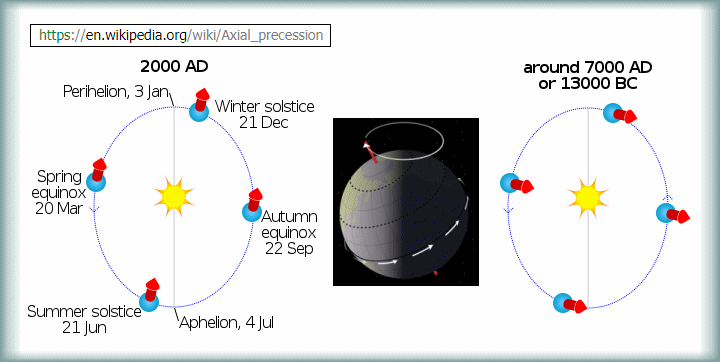Because
there are 1.296 million arc-seconds in any
cycle,
a period of 25772 years will yield 1296000/25772
= 50.287 arc-seconds per year.
The precession of the Earth's equinox is then given as 5029
arc-seconds per
century.
How does that terrestrial event equate to Mercury's orbit?
In two different ways:
If we adjust for the effect on our spatial position,
then we only get an amount of
0.1 arc-seconds per century that Axial Precession
changes our perspective of Mercury. But it distorts our temporal
perception of the length of a year more profoundly.
This is because the time it takes for the Earth to orbit the
Sun is: 365.256 days - a sidereal
year, which is not the time it takes between a pair of winter
solstices: 365.242 days - the tropical
year.
If we mistakenly use the tropical year, instead of
the sidereal year then we observe the orbit of Mercury
(or any other planet), with an error of 5029
arc-seconds per century. This 50.29 arc-seconds
per year is then also exactly the difference between the sidereal
and tropical year, which equates to about 20
minutes of time.
If you are constructing an n-body algorithm of the solar system
then you must pay attention to this, and the section later
where I explain all of this in more detail: Sidereal
Year or Tropical Year. But the 5029 arc-second
per century amount is an error that needs to be understood
as a matter of rigorous methodology.
In fact, most others have been able to skip over this detail
completely, and simply calculate Mercury's Perihelion Precession
using the proper sidereal year. And there certainly
is much utility in this route. But in doing this, they would
have accepted the notion that the other planets can cause
the Earth's axis to wobble every 26000 years
or so.
I shall put this aside for now, and just take the precise
and shorter route of what is the correct way to measure Mercury's
Perihelion Precession according to sidereal
years; which properly then avoids the Precession of the
Equinox and its incorrect yield from tropical
years.









